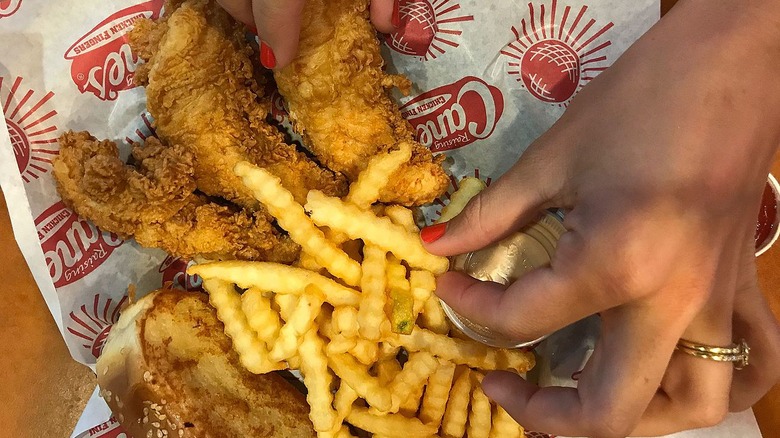Ever bitten into one of Raising Cane’s juicy chicken fingers and wondered, “Dang, where does this delicious chicken come from?” I’ve asked myself this same question countless times while dipping those perfect tenders into that legendary Cane’s sauce. Well, I did some digging to find out exactly where Raising Cane’s gets their never-frozen chicken, and what I discovered might surprise you.
The Foundation: Raising Cane’s Commitment to Quality
Raising Cane’s Chicken Fingers, founded by Todd Graves in 1996, has built their entire business model around one simple concept serving the highest-quality chicken fingers possible. Unlike many fast-food competitors who cut corners, Cane’s has stuck to their guns about using fresh, never-frozen chicken from day one
This commitment to freshness isn’t just marketing talk—it’s fundamental to why their chicken tastes so much better than the competition. The never-frozen approach gives their tenders that perfect texture crispy on the outside juicy and tender on the inside. You can literally taste the difference.
Raising Cane’s Chicken Suppliers: The Network Behind the Magic
So where exactly does this chicken come from? Raising Cane’s sources their chicken from a network of trusted suppliers across the United States. The company is pretty serious about maintaining quality across all their locations (over 210 restaurants in 18 states as of 2015, and many more today).
One of their known suppliers is OK Foods, which was even honored as Raising Cane’s “2015 Quality Supplier of the Year” at the 1st Annual Cane’s Partnership Summit. This recognition shows how seriously Cane’s takes their supplier relationships.
OK Foods has been in the chicken business for more than 70 years and operates as a vertically integrated chicken producer. What this means is they control the entire process from start to finish, including:
- A network of closely supervised family farms
- Over 800,000 feet of modern processing facilities
- End-to-end quality control
According to Trent Goins, CEO of OK Foods, “Raising Cane’s continues to grow at a rapid rate due to its excellent food quality and its unique focus on customer satisfaction.”
The Selection Process: Not Just Any Chicken Makes the Cut
Raising Cane’s doesn’t partner with just any poultry supplier. They have a rigorous evaluation process that focuses on several key areas:
1. Animal Welfare
Suppliers must demonstrate humane treatment practices, including:
- Proper housing conditions where chickens can roam freely
- Appropriate feeding programs
- Regular veterinary care
- No cages (chickens are raised in open housing)
2. Food Safety
This is non-negotiable for Raising Cane’s. Their suppliers must:
- Maintain USDA certification
- Follow strict protocols for hygiene and sanitation
- Undergo regular inspections and audits
- Implement robust food safety programs
3. Traceability
Raising Cane’s demands complete traceability of their chicken from farm to restaurant. This allows them to:
- Monitor the entire supply chain
- Quickly address any potential issues
- Ensure consistency across all locations
4. Sustainability
The company encourages suppliers to adopt environmentally responsible farming practices that:
- Minimize environmental impact
- Promote responsible resource management
- Reduce waste throughout the production process
The Never-Frozen Promise: Why It Matters
Let’s be real – freezing chicken would be WAY easier and cheaper for Raising Cane’s. But they’ve rejected this shortcut from the beginning. Here’s why their never-frozen approach makes such a difference:
-
Superior Texture – Freezing chicken damages the cellular structure of the meat, causing it to lose moisture when thawed. Fresh chicken maintains its natural juiciness.
-
Better Flavor – Fresh chicken simply tastes better and has a more authentic flavor profile.
-
Quality Control – Using fresh chicken requires a more vigilant supply chain, which means more attention to quality at every step.
To maintain this never-frozen standard, Raising Cane’s has built an impressive distribution network. Fresh chicken is delivered to their restaurants up to three times per week, with strict temperature controls throughout transportation to prevent spoilage.
The Farm-to-Restaurant Journey: Understanding Cane’s Supply Chain
The journey of Cane’s chicken from farm to your mouth is a carefully orchestrated process:
The Farms
It all begins on U.S. farms that adhere to Cane’s strict standards. The chickens are:
- Raised in environments that promote health and well-being
- Given room to move freely in open housing (not cages)
- Monitored daily for health issues
- Raised without added hormones (which is actually prohibited by law for all U.S. chicken)
Processing and Distribution
After the chickens are raised, they’re:
- Humanely processed at facilities meeting the highest safety regulations
- Quickly moved into Cane’s distribution network
- Delivered fresh (not frozen) to restaurants, sometimes multiple times per week
Restaurant Preparation
Once the fresh chicken arrives at a Cane’s restaurant:
- Crew members marinate and bread the chicken daily
- They follow exact recipes and procedures
- Everything is prepared to order
- Strict quality control measures are maintained
Common Questions About Raising Cane’s Chicken Sourcing
Still curious about where Cane’s gets their chicken? Here are answers to some frequently asked questions:
Are Cane’s chicken suppliers USDA certified?
Yep! Raising Cane’s requires all their suppliers to be USDA certified and compliant with food safety regulations.
Does Cane’s use antibiotics in their chicken?
Raising Cane’s is committed to reducing antibiotic use in their chicken supply. They work with suppliers to promote responsible practices, focusing on disease prevention rather than routine antibiotic administration.
Are the chickens raised in cages?
Nope! The chickens used by Raising Cane’s are not raised in cages. They’re generally raised in large, open houses where they have room to move freely.
How does Cane’s ensure consistent quality?
Through a comprehensive quality control program that includes regular supplier audits, strict adherence to food safety standards, and ongoing training for restaurant staff.
Can I find out the specific farms where Cane’s chicken comes from?
While they don’t typically disclose specific farm names, Cane’s emphasizes that they work with a network of trusted suppliers across the United States.
What’s in the proprietary marinade used on Cane’s chicken?
Sorry, this is a closely guarded secret! The company has only stated that it involves a blend of spices and seasonings that enhance the chicken’s natural flavor.
Is Cane’s chicken halal certified?
No, Raising Cane’s restaurants are not specifically halal certified.
Is Raising Cane’s committed to sustainable sourcing?
Yes, they encourage their suppliers to adopt environmentally friendly farming methods and minimize their environmental impact.
What happens if a supplier doesn’t meet Cane’s standards?
Raising Cane’s has a zero-tolerance policy. Suppliers who fail to meet standards are immediately suspended or terminated.
Does Cane’s use cage-free eggs in their sauces?
While information on egg sourcing isn’t readily available, customers can contact the company directly to inquire about their policies.
Why Does This Matter to Us Chicken Finger Lovers?
I gotta tell you, there’s something refreshing about a fast-food chain that’s this obsessive about quality. In an industry where cutting corners is common, Raising Cane’s dedication to sourcing the best possible chicken stands out.
Their commitment to fresh, never-frozen chicken and stringent supplier standards translates directly to what we experience as customers: consistently delicious chicken fingers that keep us coming back.
So next time you’re munching on those perfect chicken tenders, you can feel good knowing there’s a whole quality-focused supply chain behind them—from carefully selected U.S. farms to your local Raising Cane’s restaurant.
And let’s be honest, that’s probably why we’re all so addicted to their chicken in the first place. The quality really does make a difference you can taste!
The Bottom Line
Raising Cane’s gets their chicken from a network of carefully selected U.S. suppliers (including award-winning partner OK Foods) who meet stringent standards for animal welfare, food safety, and quality. Their commitment to fresh, never-frozen chicken requires a sophisticated supply chain but results in the superior taste and texture that’s made Cane’s famous.
The next time someone asks you, “Where does Cane’s get their chicken?” you can confidently explain why their sourcing practices contribute to making those chicken fingers so darn good!
Now if you’ll excuse me, all this research has made me hungry. I think it’s time for a Box Combo with extra sauce…

The fingers at Raising Cane’s have actually won awards, and so have fans

Since the beginning, Raising Canes Chicken Fingers has specialized in one thing — chicken tenders. This was a tough concept for some to swallow, especially in the land of Cajun cuisine and on the turf of Popeyes Louisiana Kitchen. Even the founder Todd Graves never thought anyone would eat the stuff except college kids.
But for others, the concept was literally very easy to swallow. These people are called Caniacs.
So why so much hoopla over chicken? Such a wave of passionate poultry fans emerged most likely because of the product itself. As the billboards claim, the marinated, chicken breast tenderloins are hand battered by staff (or “Bird Specialists”) — then fried in canola oil.
The founder, franchise, and food have won countless awards, including “Best Chicken Tenders” from The Fasties — the fast food awards show started this year by Thrillist. But even the Caniacs have claim to some (non-physical) award. Raising Canes was recognized as having the “Most Loyal Guests” in the fast-casual segment in Technomics 2018 Consumers Choice Awards.
But those award-winning fingers dont do it alone. They are side-kicked by crinkle fries, coleslaw, Texas Toast, and another gem of the menu — Canes Sauce.
They’re on their third Cane

Despite the mega chicken chains original (almost) handle, the sockeye salmon, the restaurant was thankfully named for founder Todd Graves Labrador retriever who was kicking around the construction site of the original location.
The original Raising Cane mascot was a friendly, yellow lab — and is now referred to as Raising Cane I. After the pup eventually passed, Graves wife, Gwen, pulled the ultimate Christmas morning surprise — a yellow lab puppy. They named her Raising Cane II, and she became a certified pet therapy dog. She spent her time visiting childrens hospitals with mom (i.e. Gwen) and probably brother and sister (Todd and Gwens two human kids). She even had her own Instagram account.
Raising Cane II died in 2016, but her legacy was soon followed by Cane III. The new Raising Canes mascot debuted during the 2018 Louisianas Washington Mardi Gras in Baton Rouge — where the local news station said, “Graves held the little guy up in true Lion King fashion.”
